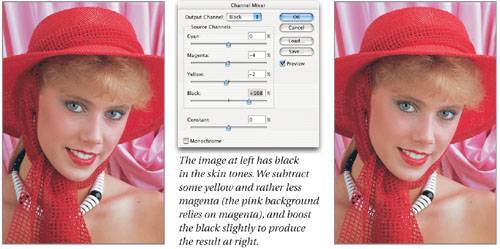Channel Mixer
| The Channel Mixer does what it saysit lets you mix the channels, combining content from one or more channels and feeding it into another. We find it useful for getting grayscale images out of color ones (see "The Color of Grayscale" in Chapter 12, Essential Image Techniques), but its usefulness as a color-correction tool is less obvious. We don't use Channel Mixer as a global correction tool on RGB images, though we sometimes use it to make local corrections, typically to bring out highlight or shadow detail that's only present in one channel. On CMYK files, it's useful for tweaking the black plate in specific color ranges. We show one such scenario in Figure 6-69. The original separation setup added black into the skin tones, making them muddy. We'd rather fix this by going back to the RGB original and reseparating the image, but that's not always possible. Lightening the black plate in Levels or Curves would destroy the contrastwe only want to change the skin tonesand the Channel Mixer provides an easy means of doing so, with better feedback and finer control than Selective Color. We set the output channel to black; then we subtract some of the magenta and yellow channels from the black, and boost the black so that we preserve the black values in the shadows. Figure 6-69. Removing black from skin tones |
EAN: N/A
Pages: 220